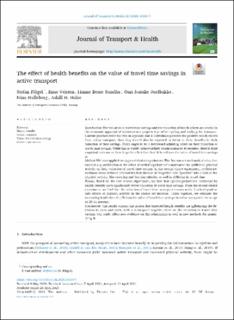| dc.contributor.author | Flugel, Stefan Markus | |
| dc.contributor.author | Veisten, Knut | |
| dc.contributor.author | Sundfør, Hanne Beate | |
| dc.contributor.author | Jordbakke, Guri Natalie | |
| dc.contributor.author | Hulleberg, Nina | |
| dc.contributor.author | Halse, Askill Harkjerr | |
| dc.coverage.spatial | Norway | en_US |
| dc.date.accessioned | 2021-07-27T12:00:17Z | |
| dc.date.available | 2021-07-27T12:00:17Z | |
| dc.date.created | 2021-07-02T11:49:47Z | |
| dc.date.issued | 2021-04-28 | |
| dc.identifier.citation | Journal of Transport and Health. 2021, 21 (June 2021), 1-15. | en_US |
| dc.identifier.issn | 2214-1405 | |
| dc.identifier.uri | https://hdl.handle.net/11250/2765370 | |
| dc.description.abstract | Introduction The valuation of travel time savings and the valuation of health effects are crucial in the economic appraisal of infrastructure projects that affect cycling and walking for transport. Current practices treat the two in separate; but if individuals perceive the positive health effects from active transport, then they should also be expected to factor in these benefits in their valuation of time savings. There ought to be a downward-adjusting effect on their valuation of travel time savings. While this is widely acknowledged within transport economics, there is little empirical evidence on how large the effect from health benefits on the value of travel time savings is. Method We have applied two types of choice experiments. The first was a travel mode choice, that enabled a quantification of the effect of cyclist's/pedestrian's motivation for additional physical activity on their valuation of travel time savings. In the second choice experiment, cyclists/pedestrians chose between alternatives that differed in “negative” and “positive” side effects of the physical activity, like sweating and burning calories, as well as differing in travel time. Results Based on the first choice experiment, we find that cyclists/pedestrians motivated by health benefits have significantly lower valuation of travel time savings. From the second choice experiment, we find that the valuation of travel time savings decreases as the levels of positive side effects of physical activity in the choice set increase. Taken together, we estimate the decreasing health-benefit effect on the value of travel time savings in active transport in the range of 20–65 percent. Conclusions The results support the notion that expected health benefits are influencing the decisions to cycle and walk, with a subsequent negative effect on the valuation of travel time savings. Our study offers new evidence on this relationship as well as new methods for quantifying it. | en_US |
| dc.language.iso | eng | en_US |
| dc.publisher | Elsevier | en_US |
| dc.rights | Navngivelse 4.0 Internasjonal | * |
| dc.rights.uri | http://creativecommons.org/licenses/by/4.0/deed.no | * |
| dc.title | The effect of health benefits on the value of travel time savings in active transport | en_US |
| dc.type | Peer reviewed | en_US |
| dc.type | Journal article | en_US |
| dc.rights.holder | © 2021 The Authors. Published by Elsevier Ltd. | en_US |
| dc.source.articlenumber | 101074 | en_US |
| dc.description.version | publishedVersion | en_US |
| cristin.ispublished | true | |
| cristin.fulltext | original | |
| cristin.qualitycode | 1 | |
| dc.identifier.doi | 10.1016/j.jth.2021.101074 | |
| dc.identifier.cristin | 1920036 | |
| dc.source.journal | Journal of Transport and Health | en_US |
| dc.source.volume | 21 | en_US |
| dc.source.issue | June 2021 | en_US |
| dc.source.pagenumber | 1-15 | en_US |
| dc.relation.project | Norges forskningsråd: 283321 | en_US |

